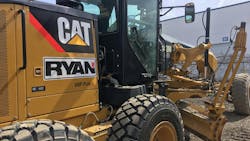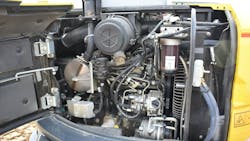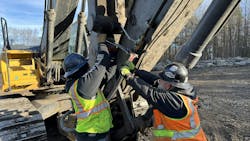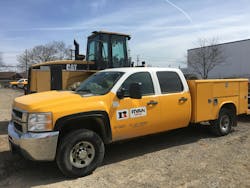How to Standardize and Streamline Your PM Program
Key Highlights
In this article, you will learn:
- How to move to condition-based maintenance.
- How to standardize scheduled maintenance.
- How fluid sampling extends intervals.
“Preventive maintenance for a mixed fleet is really challenging,” says Aaron Mayer, director of finance and equipment for earthmover Ryan Incorporated Central, Janesville, Wisconsin.
“I’ve read a lot of studies that have said every dollar spent on preventive maintenance saves $5 of repairs down the road. We talk about that internally; we believe that,” says Mayer.
To that end, Mayer has looked to streamline and enhance Ryan’s PM program to bring it to predictive, or condition-based maintenance.
His approach has been multifold, including standardization of schedules and taking a deep dive on fluids and filtration.
Some of Ryan’s best practices picked up along the way are simple; other have come from research and analysis.
“One best practice we’ve worked really hard to adopt is writing the date of install and hours on filters,” Mayer says. “Walking through the Ritchie Bros. Orlando auction, we noticed that maybe 30% of the machines had them, far less than half.
“It seems elementary, but what it does if you get into the right rhythm is set up an atmosphere where your service people expect to be doing something every 200 or 500 hours,” Mayer says. “Having these hours and dates on the filters is a safety valve, so if someone's walking past it they know if something hasn't been done.”
Standardizing schedules
“Part of the complexity of a mixed fleet comes down to OEM recommendations,” Mayer says. “There are different fluids and filters, different intervals. On excavators, for instance, there are a lot of differences on factory-fill fluids and the PMs that are expected.
“When you lay out all the OEM specs and compare them to one another, it’s frightening,” Mayer says. “It's a mess.”
The first thing Ryan did is standardize schedules. It took schedules for every machine, put them in a spreadsheet and compared the recommendations for actions such as engine oil changes, final drive fluid changes, hydraulic fluid changes, and filter changes.
"We asked 'Is there a common factor from an hour meter or odometer perspective to program everything on the same grid?'" Mayer says. "What we found is that we should do everything with an interval of 250 hours on the off-highway side, and on the on-highway side, everything was 5,000 miles."
“Once you’re able to structure all of your PMs this way, your maintenance personnel are able to anticipate when something's due,” Mayer says. “If everything is based oon the same factor, it’s easier to do that.”
Lubricants
Each OEM, as part of its recommended maintenance, usually has its own branded lubricants.
“On the lubricant side, we have a primary lubricant supplier, so we worked with their engineers to evaluate all the the different lubricants that were prescribed for what we have to boil down the number of products we're carrying to six or seven,” Mayer says.
More maintenance best practices
- How Ryan Incorporated Central uses telematics.
- Ryan’s yearly vendor reviews help prevent dealer deterioration.
- Downsizing lube trucks allows non-CDL drivers.
- App mimics Uber for techs.
- How to apply the Bradford Factor to equipment downtime.
“We have a lot of remote jobs and we have lube trucks on almost every one of our jobs,” Mayer says. “We want to minimize the number of products we carry and configure the lube trucks exactly the same."”
Ryan samples the products to make sure they are clean. Using consistent lubricants also makes trend analyses from fluid sampling more meaningful.
“If you looked at a fluid sample analysis and compared three different manufacturers of engine oils, every one of them has a different additive package, and those additive packages create noise in an analysis,” Mayer says.
“It might flag a sample that doesn’t necessarily need to be flagged, so if you can be sure that the same lubricants are used across the fleet, it will reduce a lot of extra resampling,” Mayer says.
Reducing filters
Mayer says reducing the number of filters the company uses was more difficult since it uses more than one brand.
“We worked with the suppliers of the filters we use and determined the different beta ratings and cleanliness ratings, and then talked to aftermarket filter manufacturers to figure out what ‘brand X’ filters one, two, and three cost,” Mayer says.
“The big thing is that you have to make sure they meet oil and fuel requirements. There are a lot of will-fit filters and lubricants out there, but it turns out a lot of the filters don’t meet the stringent requirements, especially when it comes to fuel systems and hydraulic systems these days.”
“So on the lubricant side, talk to their engineering department to make sure they’re hitting all the requirements, and on the filter side, work with your dealers and aftermarket parts suppliers to ensure that the ratings of those filters actually meet or exceed that of the OEM,” Mayer says.
Fluid sampling
Ryan also decided to augment its fluid sampling program to take a more proactive approach.
“With fluid sampling, the more samples you take, the more data you have, the better you’re able to identify trends,” Mayer says. “So, for example, for large excavators, for hydraulic fluid changes, we’re able to work with the OEMs and demonstrate the PM program we have in place with the fluid sampling.
“We treat almost all of them as condition based,” Mayer says. “We might have ‘brand X' that says you have to drop fluid and filters every 4,000 hours. We don’t. We are sampling it every 250 hours and changing the flluid when the samples tell us we should.”
Mayer maintains this reduces cost.
“If you really do maintain cleanliness of the fluids you’re putting into the machines and maintaining the visibility of its condition as you’re using it, and you end up changing the fluid on an excavator at 6,000 hours instead of 4,000 hours, multiply that benefit times 100 excavators and it’s pretty material,” Mayer says.
“Another thing fluid sampling did for us was that it allowed us to adjust some PM intervals outside of the condition-based hydraulic system maintenance,” Mayer says. “With frequent fluid sampling and good records of PM management, the OEMs we've worked with have been pretty receptive to us trying to adjust those intervals.”
"We can keep our 250-hour interval on machines and the 5,000 mile mark for on-highway," Mayer says."I can say that without fluid sampling, they would not make those exceptions."
About the Author
Frank Raczon
Raczon’s writing career spans nearly 25 years, including magazine publishing and public relations work with some of the industry’s major equipment manufacturers. He has won numerous awards in his career, including nods from the Construction Writers Association, the Association of Equipment Manufacturers, and BtoB magazine. He is responsible for the magazine's Buying Files.




